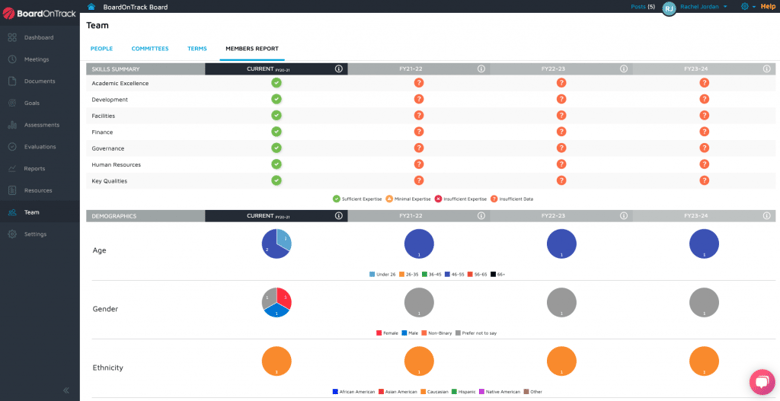Who serves on your board matters.
And who serves on your board is not only a question that can be solved with data. It’s one that must be solved with data.
Data is not biased. Data isn’t clouded by inherent biases or assumptions, who you know, what your stakeholders assert, or how hard this challenge might be to solve.
To be clear, we are not experts in diversity, equity, and inclusion (DEI). We are experts in charter school governance. And we are the evangelists for data-driven governance. We help charter school leaders make better decisions with data, not assumptions.
To fully address diversity, equity, and inclusion in charter schools nationwide, charter school boards must be diverse, equitable, and inclusive.
So we’re sharing our advice for engaging in strategic board recruiting and board composition decisions that are data-driven, actionable, and responsible.
In order to effect real change, DEI has to exist as a commitment at every level of the organization: students, staff, leadership, and governance.
A charter school’s board hires, evaluates, and supports the CEO. It decides how resources are allocated. It’s held accountable for overall academic performance and discipline data. It reviews personnel policies, including the CEO’s own DEI strategies as well as salary and promotion policies.
What happens if your board lacks appropriate DEI and a shared, clearly spelled-out focus on DEI?
What kind of candidates will they pull in for the CEO role? How will they work effectively with any CEO, especially if they come from different backgrounds?
Through what filters will they review academic or disciplinary data for the kids your schools serve?
How prepared will they be to strategically contribute to the CEO’s own DEI strategies and salary and promotion policies?
Consider the scenario that our founder, Marci Cornell-Feist, witnessed early in her own career. A mother came before the board for her child’s expulsion hearing. This mother, who was Black, found herself standing before a board of exclusively white trustees. Imagine the message this sends to the mother and parents like her; the disconnect in lived experiences informing the decisions this board might make about this child and others.
Charter schools exist to raise the bar. Board diversity should be no exception.
Charter schools are founded on the notion that our nation’s education system is broken and we must do better for our kids — for all kids, regardless of race or zip code.
Charter school boards are not elected. They’re appointed — a point that public stakeholders have taken issue with, and one that drives up public scrutiny, with questions of whether a charter school’s board truly has the community’s interests at its center.
However, a recent study found, elected public school boards are not a guarantee of effective academic oversight by the very nature of their lack of diversity.
In fact, it states, “School districts that face the largest ‘achievement gap’ … also tend to be the districts where the electorate looks least like the students.” Specifically, researchers found “majority-white electorates determining the outcome of school board elections in more than two-thirds of the majority-nonwhite school districts.”
In essence, the study finds, legacy public school boards are less diverse and not representative of the families relying on their schools in terms of race or socioeconomic status. And, “perhaps most worrying, the magnitude of the representational gap between the demographics of the electorates and the local student bodies corresponds to disparities in student achievement.”
This data suggests that, to fully deliver on the charter school promise to deliver academic excellence for every child, charter school boards must be diverse, equitable, and inclusive enough to be representative of the community counting on them. They must set the high bar for DEI, just as they have aimed to do for decades in academic excellence.
And, just as charter schools have led the way in leveraging data to achieve academic excellence, they can do so for achieving DEI in governance.
How to see the reality of your board’s diversity in data.
Data-driven governance means that board members and CEOs are driven by data, not assumptions or anecdotes. When it comes to DEI and your board, this is even more important.
We’ve built a recruiting roadmap that provides an at-a-glance look at the real makeup of your board as it stands right now — and as it will change over time.
Using data that each board member provides, our platform gives a real-time view of representation among your trustees across age, gender identity, and ethnicity. (It also digs deep into the skill sets your board members bring to the table, and where your board is showing gaps in the necessary skills.)
There is no substitute for this kind of real-time data. We’ve spoken with plenty of board chairs and CEOs to know the pain of attempting to jerry-rig or replicate this in spreadsheets, Google surveys, or other tools. Especially now, your governance team does not have time to be bogged down by such cobbled-together approaches. And this is too important to miss.

What’s more, we show you how this data will change over the next three years, based on your trustees’ term limits. As board members rotate off of the board, the data changes to show you where new gaps will emerge.
This data allows boards to see where they really are today as a team, how that will change, and what opportunities they have to make different decisions.
Talk with your board about its diversity, equity, and inclusion. Then take action.
Data-driven decision-making is only powerful if it’s actionable. To make your data actionable, follow four stages: Discussion, Goal setting, Transparency, and Partnership.
Discussion
This is a hard topic. With the right data, your conversation about diversity, equity, and inclusion is easier and more productive. You’re not bogged down by opinions, assumptions, or personalities.
Look at the data. Ask yourselves and each other the following questions. Discuss them at your next board meeting.
- What does the data tell us about the current levels of diversity on our board?
- How does our current board makeup align with our organization’s mission and vision?
- How does our current board composition align with our student population or our broader community?
Goal Setting
Setting a goal moves your board from intellectual commitment to an actionable plan. It ensures your board can hold itself accountable.
Set DEI-focused recruiting goals. Here’s an example.
By {month and year}, we will have a sustainable governing board of 12 diverse trustees who bring the needed skills to the board to ensure effective governance.
We will aim to increase diversity among our board members, increasing representation of Black and Hispanic/Latinx people among our trustees and non-voting committee members.
We will commit to increasing equity and inclusion within the board by undergoing training to learn to recognize our own biases.
Transparency
Transparency, of course, is a key piece of charter school governance.
If you’ve held this discussion at a board meeting, you’ve already started to be transparent.
In compliance with open meeting laws, you included this item on the agenda that was published in advance of your meeting. And, it was included in the approved minutes you published following the meeting. (If you need help here too, see how we simplify OML compliance.)
But, you can do more here. Perhaps this will mean a letter from the board to your families and larger community. Perhaps a statement on the website. And, if you’ve already put out a DEI statement that didn’t include your board, it might be time to revisit it.
Right now, many charter schools are putting out moving and well-thought-out diversity, equity, and inclusion statements. Some are even forming DEI Committees.
Most of these statements focus on committing to diversity, equity, and inclusion among staff and student populations.
But, we’ve seen very few DEI statements that even mention the board. Your board must also reflect the commitment you’ve made. Explicitly include them in your DEI commitment. It’s not implicit, even if the statement comes from the board.
Partnership
It’ll be important for the board to work in partnership with the CEO to stay aligned on your overall DEI commitments.
As mentioned at the start of this piece, the board has a vital role to play in understanding and supporting the CEO’s DEI efforts. Don’t lose sight of this in favor of a myopic focus on the board’s DEI alone.
And, in order to be an effective partner to your CEO, you’ll have work to do beyond making data-driven decisions about who’s on your board.
The work doesn’t end with who’s on your board. Examine your mindset and biases.
In order to effectively govern with a DEI mindset, board members must be cognitively diverse, establish a culture that embraces diverse insights, and must learn to recognize their own biases.
Board diversity is not only about checking off the boxes. Your board could be diverse in terms of age, gender identity, and ethnicity, but wholly lack cognitive diversity. To bring varied opinions, and avoid groupthink, the board must bring a variety of lived experiences.
Harvard Business Review’s advice, originally for for-profit boards, is very fitting here. Because, once you’ve achieved true diversity, you must also foster a culture that invites and supports a diversity of opinions. Especially on hard conversations.
What’s more, the board must be able to recognize its own biases. Especially where they intersect with the charter school mission of closing the achievement gap. Bellwether’s advice, though focused on legacy public school boards, provides valid advice for charter school boards.
The right training sessions can help board members better understand systemic racism and classism, alongside the historical and structural explanations for gaps in student outcomes.
A focus on equity is much more likely when school boards are culturally competent and representative of the communities they serve. Only then will systemic racism and classism give way to a system that meets the needs of all of the students it serves.
Recommended Resources
Diversity, Equity & Inclusion summer 2020 series by Education Board Partners


